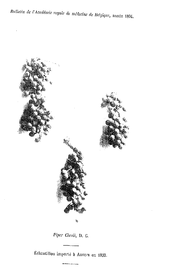Piper guineense
| Piper guineense | |
|---|---|
| | |
| Scientific classification | |
| Kingdom: | Plantae |
| Division: | Magnoliophyta |
| Class: | Magnoliopsida |
| Order: | Piperales |
| Family: | Piperaceae |
| Genus: | Piper |
| Species: | P. guineense |
| Binomial name | |
| Piper guineense Schumach. | |
| Synonyms | |
|
Piper clusii C.DC. | |
Piper guineense is a West African species of Piper; the spice derived from its dried fruit is known as West African pepper, Ashanti pepper, Benin pepper, false cubeb, Guinea cubeb, uziza pepper or (ambiguously) "Guinea pepper", and called locally kale, kukauabe, masoro, sasema and soro wisa. It is a close relative of cubeb pepper and a relative of black pepper and long pepper. Unlike cubeb pepper, which is large and spherical in shape, Ashanti peppers are prolate spheroids, smaller and smoother than Cubeb pepper in appearance and generally bear a reddish tinge.[1] The stalks of Ashanti pepper berries are also distinctly curved whilst those of cubeb pepper are completely straight.[1]
The plants that provide Ashanti pepper are vines that can grow up to 20m in length, climbing up boles of trees by means of adventitious roots. These are native to topical regions of Central and Western Africa and are semi-cultivated in countries such as Nigeria where the leaves, known as uziza, are used as a flavouring for stews. Like other members of the pepper family, Ashanti peppers contain 5-8% of the chemical piperine which gives them their hot taste. They contain large amounts of beta-caryophyllene, which is being investigated as an anti-inflammatory agent. They also contain significant proportions (10%) of myristicin, elemicin, safrole and dillapiol.
In terms of flavour, Ashanti pepper is very similar to cubeb pepper but is much less bitter and has a fresher more herbaceous flavour. Though known in Europe during the Middle Ages (it was a common spice in Rouen and Dieppe in 14th Century France), these days, its use is marginalized to West and Central Africa.
Use in cuisine

It is used in West African cuisine where it imparts heat and a pungent aroma to classic West African stews. Even in West Africa, Ashanti pepper is an expensive spice and is used sparingly. Often, a few grains are in a pestle and mortar before being added (along with black pepper) to soups or to boiled rice. The spice can also be substituted in any recipe using cubeb pepper, where Ashanti imparts a less bitter flavour. The pepper is also sometimes one of the ingredients in the Berbere spice mix used in the cuisines of Ethiopia and of Eritrea. However, West African Pepper is a highly esteemed spice in its region of origin and may be hard to get abroad; thus, long pepper is more often used in Berbere.
As a preservative
Research shows that Ashanti peppers have preservative and anti-oxidant properties. In a comparison study of three native West African peppers on the preservation of catfish, Ashanti peppers were discovered to be the most effective.[2]
References
- 1 2 Katzer, Gernot. "Cubeb pepper (Piper cubeba, cubebs)". Gernot Katzer's Spice Pages. Retrieved 26 May 2015.
- ↑ Kiin-Kabari, DB; Barimalaa IS; Achinewhu SC; TA Adeniji (2011). "Effects of extracts from three indigenous spices on the chemical stability of smoke-dried catfish (Clarias lezera) during storage". African Journal of Food, Agriculture, Nutrition and Development. 11 (6). Retrieved 11 November 2012.
External links
- Recipe for West African 'Ashanti Chicken' incorporating Ashanti Pepper
- Do you know the health benefits of Piper guineense ‘Uziza’?